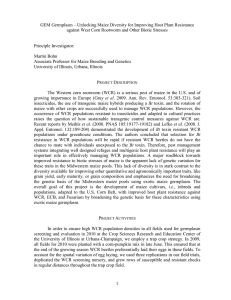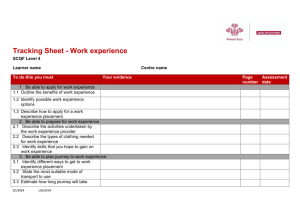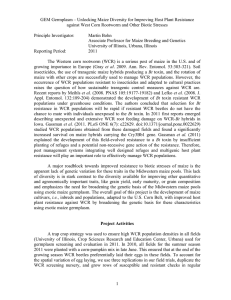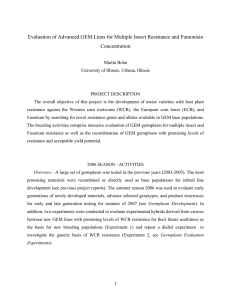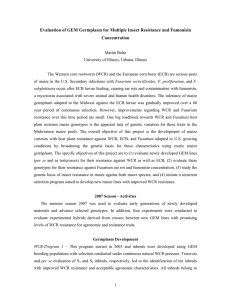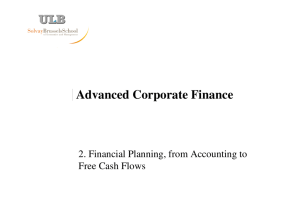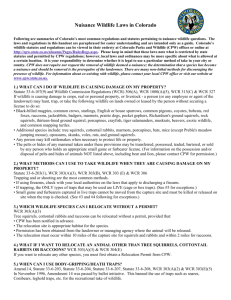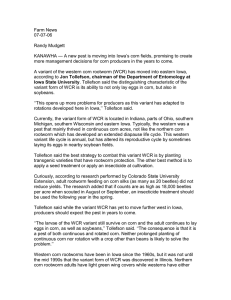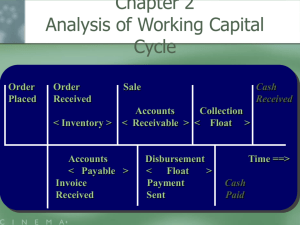GEM Germplasm – Unlocking Maize Diversity for Improving Host Plant... against West Corn Rootworm and Other Biotic Stresses
advertisement
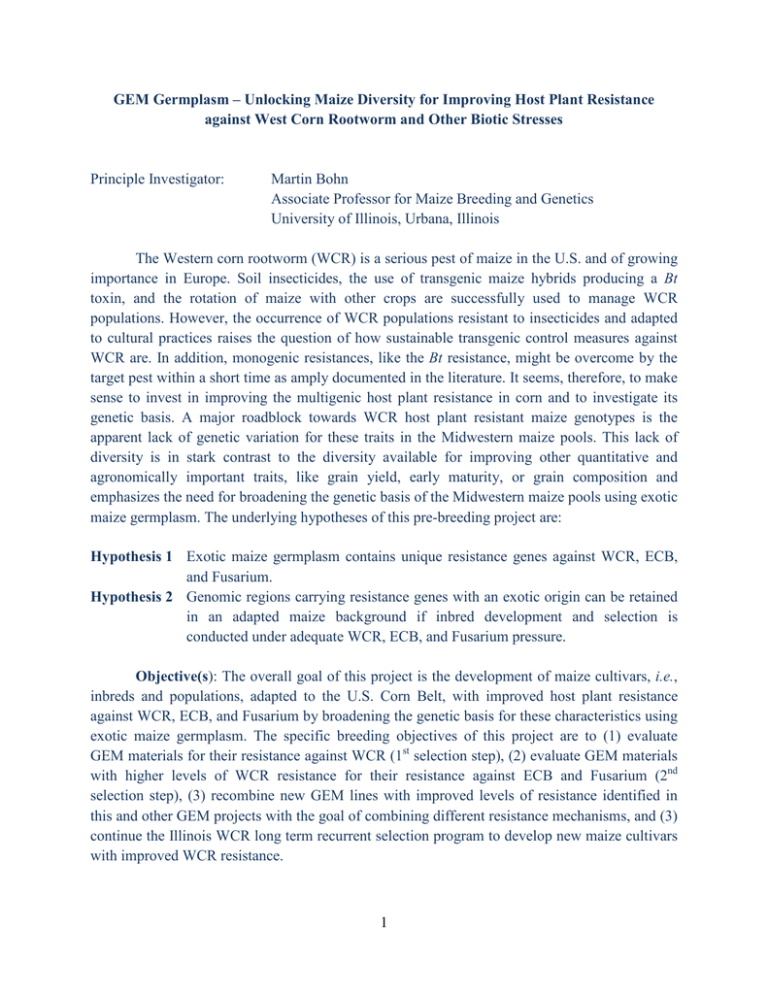
GEM Germplasm – Unlocking Maize Diversity for Improving Host Plant Resistance against West Corn Rootworm and Other Biotic Stresses Principle Investigator: Martin Bohn Associate Professor for Maize Breeding and Genetics University of Illinois, Urbana, Illinois The Western corn rootworm (WCR) is a serious pest of maize in the U.S. and of growing importance in Europe. Soil insecticides, the use of transgenic maize hybrids producing a Bt toxin, and the rotation of maize with other crops are successfully used to manage WCR populations. However, the occurrence of WCR populations resistant to insecticides and adapted to cultural practices raises the question of how sustainable transgenic control measures against WCR are. In addition, monogenic resistances, like the Bt resistance, might be overcome by the target pest within a short time as amply documented in the literature. It seems, therefore, to make sense to invest in improving the multigenic host plant resistance in corn and to investigate its genetic basis. A major roadblock towards WCR host plant resistant maize genotypes is the apparent lack of genetic variation for these traits in the Midwestern maize pools. This lack of diversity is in stark contrast to the diversity available for improving other quantitative and agronomically important traits, like grain yield, early maturity, or grain composition and emphasizes the need for broadening the genetic basis of the Midwestern maize pools using exotic maize germplasm. The underlying hypotheses of this pre-breeding project are: Hypothesis 1 Exotic maize germplasm contains unique resistance genes against WCR, ECB, and Fusarium. Hypothesis 2 Genomic regions carrying resistance genes with an exotic origin can be retained in an adapted maize background if inbred development and selection is conducted under adequate WCR, ECB, and Fusarium pressure. Objective(s): The overall goal of this project is the development of maize cultivars, i.e., inbreds and populations, adapted to the U.S. Corn Belt, with improved host plant resistance against WCR, ECB, and Fusarium by broadening the genetic basis for these characteristics using exotic maize germplasm. The specific breeding objectives of this project are to (1) evaluate GEM materials for their resistance against WCR (1st selection step), (2) evaluate GEM materials with higher levels of WCR resistance for their resistance against ECB and Fusarium (2nd selection step), (3) recombine new GEM lines with improved levels of resistance identified in this and other GEM projects with the goal of combining different resistance mechanisms, and (3) continue the Illinois WCR long term recurrent selection program to develop new maize cultivars with improved WCR resistance. 1 Materials and Methods Activities in the summer season 2009 were divided in germplasm development and germplasm evaluation. The WCR nursery comprised of the following germplasm sets: (1) segregating F2 populations derived from crosses between GEM-based inbreds with improved WCR resistance, (2) S5 inbreds derived from four GEM base populations and CIMMYT population MIRT-C5Y, and (3) S1 families of Cycle 0 of the Illinois WCR Synthetic. In addition, we re-evaluated a set of WCR resistant and susceptible testcrossed double haploid lines (DHLs) of a QTL mapping population derived from the cross between AR17056-16 (resistant) and LH51 (susceptible). All germplasm sets were exposed to high WCR pressure using a WCR trap crop field established in 2008. All nursery germplasm sets were blocked and repeated twice to account for the varying distribution of WCR larvae in the trap crop field. The Illinois WCR Synthetic and the QTL population were repeated three times. Entries within each nursery block were randomized in a two step procedure: first, S1 derived family sets were randomized within each block and in a second step families within each set were randomized. The QTL experiment was randomized using an incomplete block design. In addition, a grid of resistant and susceptible checks was used to (1) separate replications, (2) provide information about the spatial distribution of WCR larvae in the trap crop field, and (3) compare phenotypically experimental entries with genotypes of known level of resistance. Plants experiencing root feeding by WCR larvae show extreme stress phenotypes, which are a combination of root lodging, drought stress symptoms, stunted growth, and an increased anthesis silking interval. Individual plants in segregating F2 populations were selfed, if male and female flowering was synchronized and the plants displayed a vigorous habitus. S1 and S5 families were evaluated for the percentage of root lodged plants per plot (LOD) and their vigor on a plot basis (VIG). Vigor was rated on a 1 to 5 scale, where 1 indicated a plot with healthy plants, which did not express any stress symptoms, and 5 indicated a plot with all plants expressing severe stress symptoms (i.e., root lodging, stunted growth, drought stress, no flowering, etc.). In previous experiments we found significant positive associations between root lodging and root damage ratings with higher repeatability values for root lodging than for root damage ratings. Therefore, we use root lodging values complemented by vigor rating scores obtained under high WCR pressure as pre-screening and selection tools. Root damage was evaluated using the 0-3 node injury scale (Oleson et al., 2005). Root size and root regrowth were evaluated using 1 (large root system or intensive regrowth) to 6 (small root system or no regrowth) rating scales (Rogers et al., 1977). 2 Results and Discussion A set of 32 segregating F2 populations derived from crosses between GEM-based inbreds with improved WCR resistance were evaluated for their level of resistance. Out of these 32 populations 13 populations showed severe stress symptoms and were discarded. A set of 19 populations displayed a significantly reduced stress level across both replications. These populations consisted of crosses between AR17056-3, AR17056-4, AR17056-16, and ten DKXL212:N11a01 derived inbred lines. Resistant inbred AR17056-4 combined well with DKXL212:N11a01-09 derived inbreds, whereas AR17056-16 combined well with DKXL212:N11a01-05 derived inbreds. Only three of the 19 selected populations contained AR17056-3 as a parent. A set of 358 S5 inbreds derived from four GEM base-populations and CIMMYT population MIRT-C5Y were evaluated for their level of stress resistance under high WCR pressure. GEM-population AR16026:N1210 contributed 148 inbreds, CUBA117:S1520 104 inbreds, UR13085:N0204 65 inbreds, MIRT-C5Y 21 inbreds, and FS8A(S):S0907 2 inbreds to this test. Significant (P<0.01) differences were found between inbreds across source populations with respect to LOD and VIG. Repeatability values for both traits were ~0.3 and the association among both traits was low (rp = 0.31). The average percentage of lodged plants was 11% and ranged from 0% to 66%. The average vigor score was 3.3 and score values covered the whole range from 1 to 5. Taking into account the pedigree relationships among the S5 inbreds, we found significant differences between source populations for LOD and VIG. The mean percentage of lodged plants was lowest for population AR16026:N1210 (9%) and highest for FS8A(S):S0907 (29%). Mean vigor scores ranged from 2.9 (CUBA117:S1520) to 3.5 (AR16026:N1210). Differences between S2 derived families within source populations were highly significant (P<0.01) for most families. These results are in agreement with the evaluation of earlier generations of these materials (see Table 2, 2007 Report). In addition, it is worth mentioning that with CUBA117:S1520 derived inbreds we identified the first materials with improved stress resistance to WCR larvae feeding belonging to the Stiff Stalk heterotic pool. Given the highly quantitative nature of WCR host plant resistance, it will be advantageous to combine putatively independent sources of resistance from the Stiff Stalk and non- Stiff Stalk heterotic pools. Recent results of this project and also published work reported a low correlation between inbred per se and testcross performance (Flint-Garcia et al., 2009). Therefore, the most promising 70 S5 inbreds were testcrossed to one tester. Together with their parental inbreds, the hybrids will be evaluated for their level of WCR resistance and agronomic performance in 2010. S1 testcrosses of Cycle 0 of the Illinois WCR Synthetic were evaluated for their level of stress resistance under WCR pressure. Significant (P<0.01) differences were found between entries for LOD but not for VIG. The repeatability for percentage of lodged plants was ~0.55. The average percentage of lodged plants was 18% and ranged from 6% to 62%. The average 3 vigor score was 3.7. Based on this data, selection will be performed among S1 families. The selected S1 families will be recombined in the summer season of 2010. One goal of this project is also to further evaluate the genetic basis of the improved WCR resistance in materials selected from GEM base populations. One suitable approach is the development of segregating populations for QTL mapping. In a previous project inbred AR17056-16 derived from GEM breeding population AR17056:N2025 showed increased levels of WCR resistance. In close collaboration between the USDA-ARS (Drs. Bruce Hibbard and Ken Dashiell), AgReliant, and the University of Illinois, a population of 193 double haploid lines derived from the cross between AR17056-16 and LH51 and testcrossed to PHZ51 was produced and tested in three locations in 2008. The combined analysis across locations showed highly significant differences between DHLs with respect to their level of WCR resistance. Based on these results, we identified 20 DHLs from the resistant and susceptible tails of the population and reevaluated these for their WCR resistance using root damage ratings, root regrowth, and root size. The experiment was conducted in Brookings, South Dakota, Columbia, Missouri, and Urbana, Illinois in 2009. In contrast to 2008, we were not able to find significant differences between DHLs for WCR resistance traits. However, the most resistant and susceptible DHLs in 2008 also displayed extreme phenotypes in 2009. In accordance with Flint-Garcia et al. (2009), who suggest that hybrid vigor also contributes to improved tolerance to WCR larvae feeding, testcrosses of resistant parent AR17056-16 and resistant check NGSDCRW1 were significantly (P<0.001) more resistant to WCR larvae feeding than the inbreds per se. It is also worth mentioning that both testcross hybrids performed significantly (P<0.01) better than the commercial non-Bt check hybrid and the standard susceptible check hybrid B37×H84. Based on these results it can be speculated that hybrid vigor in combination with host plant resistance will significantly reduces root feeding damage by WCR larvae (see also above - results and discussion of S5 inbred evaluation). El Khishen et al. (2009) evaluated the resistance mechanism of recently developed genotypes with improved WCR resistance. They reported that this group of genotypes, which also included AR17056-16, had less damage, fewer larvae recovered, smaller larvae recovered, and fewer adults recovered than the susceptible controls. These results demonstrate that WCR resistance can be improved using conventional breeding procedures. However, a deeper understanding of the genetic basis of WCR resistance is needed in order to rapidly identify new sources of resistance and to efficiently combine these in agronomically acceptable cultivars. 4 References EL Khishen, A.A., M.O. Bohn, D.A. Prischmann-Voldseth, K.E. Dashiell, B.W. French and B.E. Hibbard. 2009. Native resistance to western corn rootworm (Coleoptera:Chrysomelidae) larval feeding: Characterization and mechanisms. J Econ Entomol 102(6): In press. Flint-Garcia, S.A., K.E. Dashiell, D.A. Prischmann, M.O. Bohn and B.E. Hibbard. 2009. Conventional screening overlooks resistance sources: Rootworm damage of diverse inbred lines and their B73 hybrids is unrelated. J. Econ. Entomol. 102:1317-1324. Oleson, J. D., Y. L. Park, T. M. Nowatzki and J. J. Tollefson. 2005. Node-injury scale to evaluate root injury by corn rootworms (Coleoptera: Chrysomelidae). J. Econ. Entomol. 98: 1-8. Rogers, R. R.,W.A. Russell and J. C. Owens. 1977. Expected gains from selection in maize for resistance corn rootworms. Maydica 22: 27-36. 5
